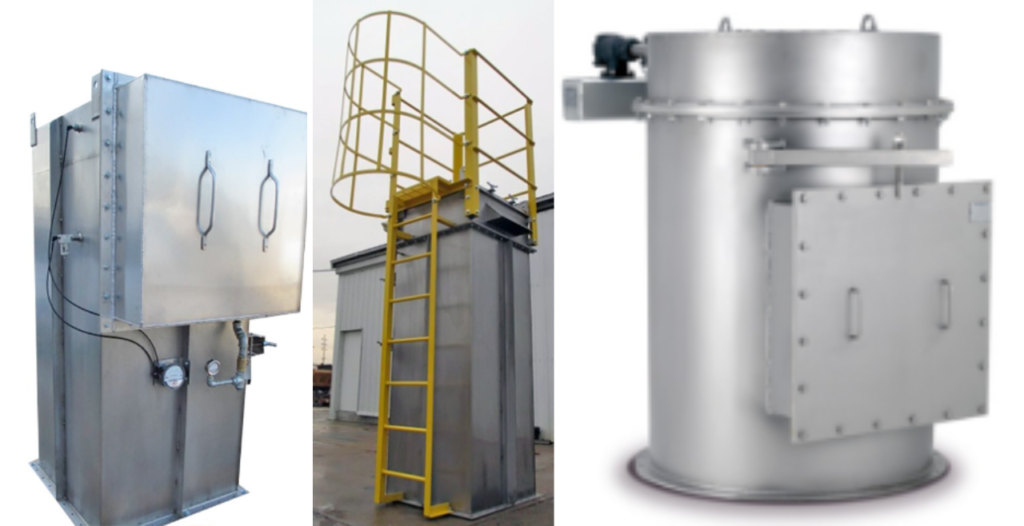AIR POLLUTION CONTROL SYSTEMS
Bin Vent Filters
Bin Vent Filter Systems, also known as dust collectors or bin vent dust collectors, are crucial components in various processing industries. They are used to capture and filter airborne dust and particulate matter generated during material handling, storage, and manufacturing processes. Bin vent filter systems help maintain clean air quality, protect equipment, and ensure compliance with environmental regulations. In this detailed overview, we will discuss the key aspects of bin vent filter systems, including equipment, working principles, advantages, disadvantages, applications, materials of construction (MOC), and provide a summary. |
| 1. Working Principles: Bin vent filter systems operate on the principles of filtration and separation, capturing airborne dust and particulate matter from exhaust air or gas streams. The key working principles include: |
| Capture: Dust-laden air or gas is drawn into the bin vent filter system through an inlet. |
| Filtration: The dust-laden air passes through a filter medium, typically composed of filter bags or cartridges. These filters trap and retain the dust particles while allowing clean air to pass through. |
| Cleaning: As dust accumulates on the filter medium, it reduces airflow and filtration efficiency. Bin vent filter systems employ cleaning mechanisms such as reverse air, pulse-jet cleaning, or shaker mechanisms to dislodge and remove the collected dust. |
| Collection: The dislodged dust falls into a hopper or collection chamber, where it can be discharged for disposal or recycling. |
| 2. Equipment: Bin vent filter systems consist of several essential components and technologies: |
| Filter Bags or Cartridges: These are the primary filtration media that capture and retain dust particles. The choice of filter material depends on the application and the properties of the dust being collected. |
| Housing or Enclosure: The filter bags or cartridges are housed in a structure designed to maintain airflow and create a controlled environment for efficient filtration. |
| Cleaning Mechanisms: Systems may employ reverse air, pulse-jet cleaning, or shaker mechanisms to clean the filter bags or cartridges. |
| Hopper and Discharge Devices: Dust collected in the filter system falls into a hopper and can be discharged for disposal or recycling. |

| 3. Advantages: |
| Effective Dust Control: Bin vent filter systems are highly efficient at capturing and removing airborne dust and particulate matter. |
| Space-Efficient: They are compact and can be installed in limited space. |
| Cost-Efficient: Operating costs are often lower compared to other air pollution control technologies. |
| Compliance: Helps industries meet air quality regulations and emissions standards. |
| Extended Equipment Life: Reduces the risk of equipment damage caused by dust buildup. |
| 4. Disadvantages: |
| Maintenance: Regular maintenance is required to replace filter bags or cartridges, and cleaning mechanisms may require attention. |
| Energy Consumption: Energy is needed for fan operation and cleaning processes. |
| Limited Use for Wet Particles: Bin vent filter systems are not suitable for filtering wet or sticky materials. |
| Temperature Limits: Filter materials may have temperature limitations. |
| Limited Use for High Dust Loadings: May require frequent filter replacement or cleaning for applications with high dust loadings. |
| 5. Applications: Bin vent filter systems find applications in various industries to control emissions and maintain air quality, including: |
| Bulk Material Handling: Capturing dust generated during material transfer, storage, and conveying processes. |
| Food and Beverage: Collecting flour, sugar, and food ingredient dust in processing facilities. |
| Pharmaceuticals: Controlling dust generated during drug manufacturing and blending processes. |
| Chemicals: Capturing dust from chemical processing, mixing, and packaging operations. |
| Woodworking: Collecting wood dust and sawdust in woodworking shops and mills. |
| Mining and Minerals: Reducing dust emissions from material handling, crushing, and screening operations. |
| 6. Materials of Construction (MOC): The choice of materials for bin vent filter systems depends on factors such as the type of dust, temperature, and chemical compatibility. Common MOCs include: |
| Carbon Steel: Suitable for general industrial applications. |
| Stainless Steel: Used in food processing and corrosive environments. |
| Fiberglass Reinforced Plastic (FRP): Corrosion-resistant and lightweight, suitable for certain applications. |
| Special Coatings: Some components may have specialized coatings for increased durability. |
| 7. Summary: Bin vent filter systems are essential components in processing industries for efficient removal of airborne dust and particulate matter. They operate on principles of filtration, separation, cleaning, and collection. These systems offer advantages such as effective dust control, space efficiency, and compliance with environmental regulations. However, they require regular maintenance, energy consumption, and may have limitations for wet or high dust loading applications. Bin vent filter systems find applications in a wide range of industries, with the choice of materials of construction tailored to specific needs and environmental conditions. |


 Sales & Marketing:
Sales & Marketing:  Service Supports:
Service Supports:  Website:
Website: 